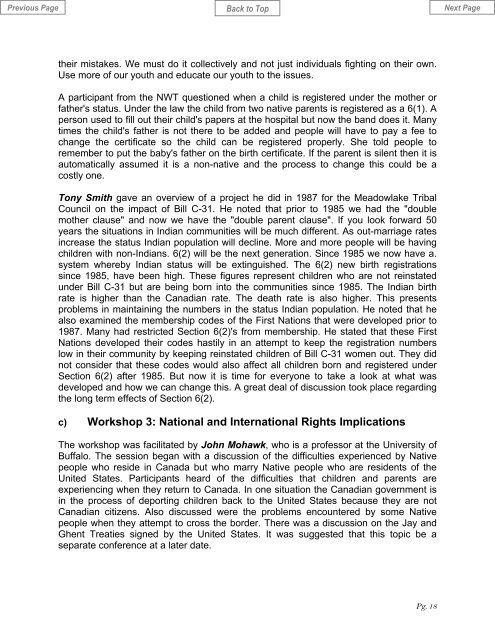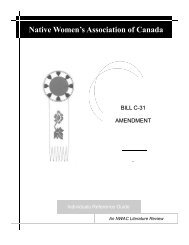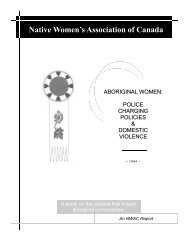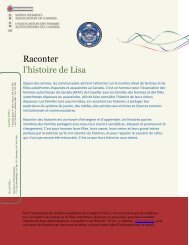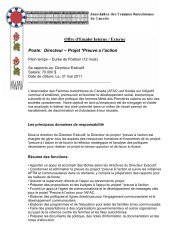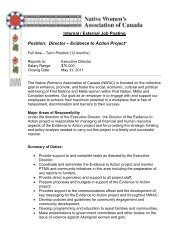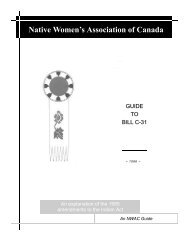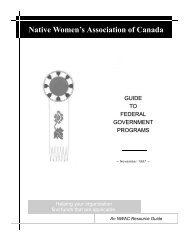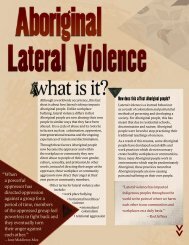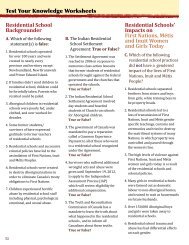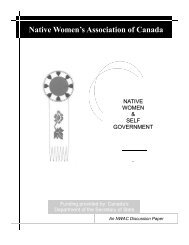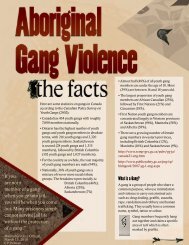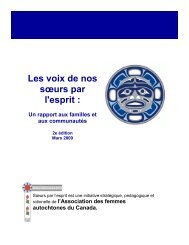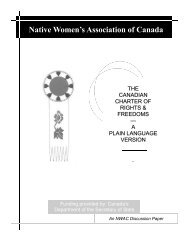BILL C-31 - Native Women's Association of Canada Website
BILL C-31 - Native Women's Association of Canada Website
BILL C-31 - Native Women's Association of Canada Website
- No tags were found...
You also want an ePaper? Increase the reach of your titles
YUMPU automatically turns print PDFs into web optimized ePapers that Google loves.
their mistakes. We must do it collectively and not just individuals fighting on their own.Use more <strong>of</strong> our youth and educate our youth to the issues.A participant from the NWT questioned when a child is registered under the mother orfather's status. Under the law the child from two native parents is registered as a 6(1). Aperson used to fill out their child's papers at the hospital but now the band does it. Manytimes the child's father is not there to be added and people will have to pay a fee tochange the certificate so the child can be registered properly. She told people toremember to put the baby's father on the birth certificate. If the parent is silent then it isautomatically assumed it is a non-native and the process to change this could be acostly one.Tony Smith gave an overview <strong>of</strong> a project he did in 1987 for the Meadowlake TribalCouncil on the impact <strong>of</strong> Bill C-<strong>31</strong>. He noted that prior to 1985 we had the "doublemother clause" and now we have the "double parent clause". If you look forward 50years the situations in Indian communities will be much different. As out-marriage ratesincrease the status Indian population will decline. More and more people will be havingchildren with non-Indians. 6(2) will be the next generation. Since 1985 we now have a.system whereby Indian status will be extinguished. The 6(2) new birth registrationssince 1985, have been high. These figures represent children who are not reinstatedunder Bill C-<strong>31</strong> but are being born into the communities since 1985. The Indian birthrate is higher than the Canadian rate. The death rate is also higher. This presentsproblems in maintaining the numbers in the status Indian population. He noted that healso examined the membership codes <strong>of</strong> the First Nations that were developed prior to1987. Many had restricted Section 6(2)'s from membership. He stated that these FirstNations developed their codes hastily in an attempt to keep the registration numberslow in their community by keeping reinstated children <strong>of</strong> Bill C-<strong>31</strong> women out. They didnot consider that these codes would also affect all children born and registered underSection 6(2) after 1985. But now it is time for everyone to take a look at what wasdeveloped and how we can change this. A great deal <strong>of</strong> discussion took place regardingthe long term effects <strong>of</strong> Section 6(2).c) Workshop 3: National and International Rights ImplicationsThe workshop was facilitated by John Mohawk, who is a pr<strong>of</strong>essor at the University <strong>of</strong>Buffalo. The session began with a discussion <strong>of</strong> the difficulties experienced by <strong>Native</strong>people who reside in <strong>Canada</strong> but who marry <strong>Native</strong> people who are residents <strong>of</strong> theUnited States. Participants heard <strong>of</strong> the difficulties that children and parents areexperiencing when they return to <strong>Canada</strong>. In one situation the Canadian government isin the process <strong>of</strong> deporting children back to the United States because they are notCanadian citizens. Also discussed were the problems encountered by some <strong>Native</strong>people when they attempt to cross the border. There was a discussion on the Jay andGhent Treaties signed by the United States. It was suggested that this topic be aseparate conference at a later date.Pg. 18


